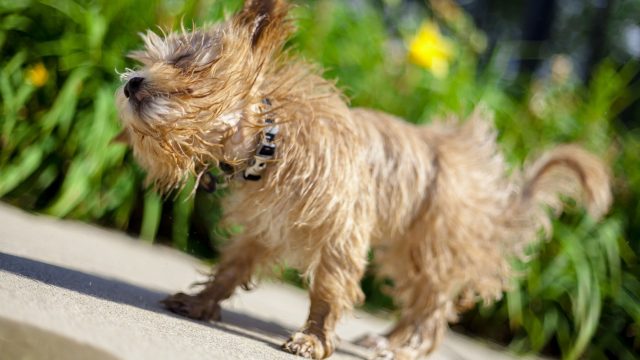Los dogsthose faithful companions who make our life happy with their presence, have customs and behaviors that sometimes we do not understand. One of those behaviors is the time when our Hairy friend It shakes when it is wet. Have you ever wondered why they do? At first glance, it might seem like a spontaneous reactionbut the truth is that this act has a much deeper explanation and scientific of what we imagine.
Dogs do not shake for mere fun, or to “free themselves” from the Water discomfort. The reason behind this curious gesture is linked to its biology and its more primitive instincts. A recent study has revealed details on how and why this movement reflects a Natural Defense Mechanism That goes far beyond what we thought.
Why do dogs shake when they are wet?
The first thing we should understand is that the act of shaking has a very logical explanation: dogs do it to Eliminate excess water from your fur. When a dog gets wet, especially if it has been in the rain, the water accumulates in its skin and hair.
When shaking, quickly and energetically, manages to detach a lot of that water, accelerating the drying process and helping not to cool so much. This behavior is very useful for prevent the body from losing heat quicklysince moisture can interfere with its natural temperature regulation mechanisms.
However, reason does not end there. The behavior of shaking is an instinctive reflection deeply rooted in dogs. This reflex is activated when certain stimuli, such as moisture or even annoying insects in their skin, cause a sign that leads their brain to order the shaking in other words, it is not only a “voluntary” act, but a reaction that is activated in your nervous system as an adaptive response to certain conditions.
This behavior is also observed in others hairy mammalsS, such as cats, horses and even some rodents. The key is in a specific type of receiver in the skin of dogs: the low threshold mechanoreceptors of the f fiber (C-LTMR). These receptors are responsible for perceiving any type of stimulus that can bother the animal, such as water or itching. Once these receptors are activated, they send a signal to the brain that makes the dog satisfy.
A study published in the magazine Science He investigated this phenomenon and discovered that these receptors not only respond to moisture, but also to sensations of discomfort such as those that occur when an insect comes into contact with the skin of the animal. In this way, the fact of shaking also acts as an answer to any stimulus that is annoying or irritating.
Thermoregulation
One of the most interesting aspects of dog behavior when shaking after getting wet is their relationship with thermoregulation. Dogs, like all mammals, have a layer of hair that fulfills the function of isolate your bodyprotecting it from cold and moisture.
However, when they get wet, the hair loses much of that Insulating capacity. The water that is trapped in the fur can quickly cool the animal, and in a cold environment, this can be very dangerous.
This is where the function comes into play shaking thermoregulator. When the dog shakes, the rapid and repeated movement helps the accumulated water detach more effectively, restoring part of its insulating capacity and preventing its body from losing heat quickly.
In fact, shaking is so efficient that it is estimated that a dog can eliminate until 70% of the moisture of your fur In seconds. This process is incredibly effective to prevent the dog from cooling, and is vital for their well -being, especially in cold conditions.
Similar behaviors in nature
This instinct is not exclusive to dogs. Other mammals, such as cats or even horses, also shake when they are wet. In the case of horses, for example, the shake also has the function of eliminating moisture from the fur and allowing The animal recovers its body temperature. In the case of cats, although sometimes they are more delicate, the shaking also helps them get rid of water, although they do it with softer movements.
What all these mammals have in common is the need to adapt to your environment. Shaking is a natural reflection that helps each one stay dry and warm, which is essential for their survival. This adaptation is key to animals that, due to its nature, depend on its ability to regulate body temperature and maintain its fur in optimal conditions.




